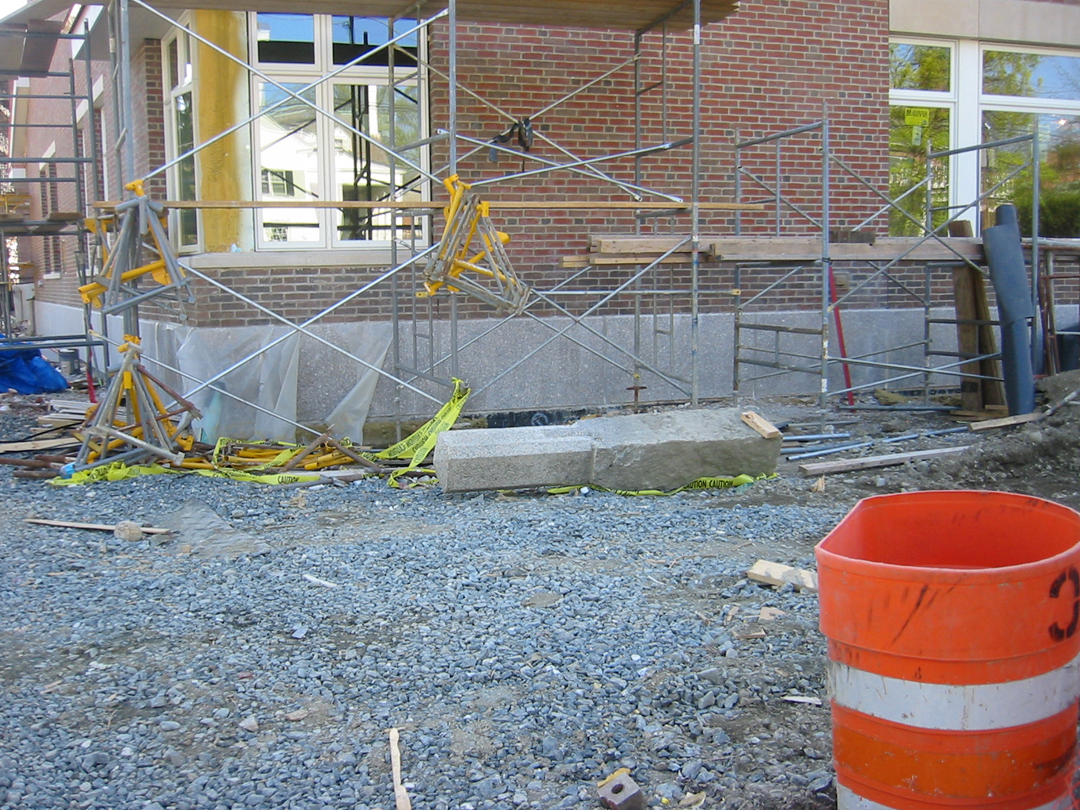The OPDC continues its generous photographic documentation of the Bradley/Gerry demolition: one view shows Kemeny with Berry in the background, as it was meant to be seen, although just a little bit of Bradley is still standing.
Category Archives: north campus
Variations on Berry Row
The urbanism of the Life Sciences Building
The OPDC’s updated Construction Maps show the north campus finally knitting together.
The Life Sciences Building looks like it will serve as a gateway building, form a wall defining two of the bounds of the campus, and partially enclose an informal quadrangle at the Medical School.
Shower Towers’ demolition ongoing
Calling it “Berry Row”
The campus urban space north of Berry Library does not seem to have an official name yet. Although it is smaller and less formally designed than the Green or Tuck Mall, it is analogous to those two spaces in the way it extends from Baker Library, and Dartmouth is about to give its landscape an ambitious redesign by Richard Burck Associates. The space needs an official name.
Here’s hoping it gets called Berry Row, a name that several people have suggested already.* The name is conservative, and it makes sense: the three buildings that will line the west side of the space (Kemeny Hall, some future building, and Moore Hall) are analogous to the three-part Dartmouth Row and its progeny, Fayerweather Row and Massachusetts Row. Each of those rows creates a public space in front of it that may also be known by the name of the row.
Particular sites within the space still may have their own names, such as the proposed Alumni Plaza (nixed in 2007 Class Treasurers Meeting pdf).
*”Berry Row” was big in 1998:
- [William D. Brawley?], Interface 29:2 (Winter 1998), 10 (pdf).
- Alex Shartsis, “New Math Building Will Honor Kemeny,” The Dartmouth (22 July 1998).
- William D. Brawley, “For Some People, It’s Becoming Increasingly Difficult to Tell Where Traditional Libraries Stop and Traditional Computing Services Begin,” Dartmouth College Library Bulletin (November 1998).
—–
[Update 11.12.2012: Broken link to 2006 Class Treasurers Report replaced with link to 2007 report.]
[Update 08.31.2013: Broken link to 2007 report pdf removed.]
Kemeny/Haldeman brick pattern explained
The Kemeny/Haldeman project page notes that the patterns in the building’s decorative brick display a Fibonacci sequence (0, 1, 1, 2, 3, 5, 8, etc.). The pattern comprises a field of soldier-course bricks from which certain bricks protrude.
The Math Department’s previous headquarters, Bradley Hall (connected to Gerry Hall as the “Shower Towers”), was known to display some pattern in the arrangement of its blue, green, and white tiles, although what it represented did not seem to be commonly known.
[Update 12.31.2006: information on pattern added.]
’53 Commons renderings released
The Class of ’53 Commons project page is up, providing plans and elevation drawings for Dartmouth’s second major dining hall. The building will stand behind Dick’s House and feature a south-facing colonnade behind a lawn (see perspective rendering).
What appears to be the new headquarters of the Office of Residential Life will occupy the ’53 Commons as well (see second-level plan).
Berry Row’s south end taking shape
The creation of Berry Row as a campus space is making progress as the landscaping for Kemeny/Haldeman, designed by Richard Burck Associates, gets underway.
The demolition of Bradley/Gerry
Bradley-Gerry demolition is underway. The granite cladding will be reused in other projects.
One particularly appealing photo from the photo page shows the buildings’ memorable old Modernist chairs with their built-in writing surfaces.
Various building topics
The Dartmouth and Vox have covered a number of building-related topics recently:
- Zoning for the 53 Commons north of Maynard Street
- The dedication of Kemeny Hall and the Haldeman Centers on the Kiewit site
- The Real Estate Office, which is redeveloping the block south of the Hop
- The Faheys’ gifts
- The Records Management office, which has moved out of Centerra to Etna Road in Lebanon:

—–
[Update 11.10.2012: Broken link to Records Management fixed.]
More preservation in the computer age
Google’s recent acquisition of the garage where it began as a company in 1998 and the preservation of the garage where Hewlett and Packard began working in 1938 point out the importance of documenting Bradley and Gerry Halls and marking their sites after they are demolished, since they have some role in the history of computing. Demolition begins as soon as this month.
Bradley is not, however, the place where Kemeny and Kurtz and others created BASIC in 1964, as reported here in “A Plea for the Shower Towers.” A College news release states that BASIC was invented in College Hall, and that is indeed where the school put its GE-235 during February of 1964 after taking delivery of it. BASIC first ran that May and the school moved the machines to the existing Bradley Hall later.
New buildings named
A press release on the names of the new dormitories includes two apparent firsts by Dartmouth: the first building, or part of a building, named for Samson Occom (Occom Commons in the McLaughlin Cluster) and the first building given someone’s first name or nickname: McLane Hall is still named for John Roy “Judge” McLane ’07, but it is switching to Judge Hall.
Names for five new dorms not announced
The school seems not to have announced very loudly at the end of last month that the new Tuck Mall dorms will be named (from west to east) McLane Hall and Fahey Hall.
What happened to the old McLane Hall in the River Cluster? It has been renamed Judge Hall.
The three remaining dorms in the new McLaughlin Cluster will be named Thomas, Goldstein, and Rauner Halls (see map). Rauner will be the northernmost in the eastern trio, of which Bildner and Berry were named previously; Thomas and Goldstein Halls will be the northern and central buildings, respectively, in the western trio, of which Byrne II already has been named.
E.K. Smith’s post is down but survives
The possibly-1860s granite post mentioned earlier as surviving the Kemeny Hall construction has been pulled, but the fact that it remains at the construction site encourages the speculation that it will be replaced when the building is finished:
Design forecast released
The Office of Planning, Design & Construction has revealed an unusual schedule of all the buildings and other construction projects to be completed on campus through October, 2010. This comes with a larger version of the master plan than has been available in the past. The documents state that:
-Bradley-Gerry demolition will end during September, 2007.
-The Life Sciences Building, which will stand east of Vail/Remsen, will be built starting early during 2007, with design starting soon. No architect seems to have been announced yet.
-Design for the dining hall to replace Thayer Hall will begin this summer. No architect has been announced for this project either, although Centerbrook was involved in the master planning for the student center area.
McLaughlin buildings looking real
The latest McLaughlin photos show the buildings starting to look like a real place, with the view of the corner of Maynard and College now recognizable.
Five of six buildings now named in McLaughlin Cluster
Dartmouth announced today that Bruce ’78 and Diana Rauner and Jack ’74 and Debbie Thomas will have two of the three dormitories in one of the trios of the McLaughlin cluster named for them.
That leaves one building without a name…
New dining hall will be the Class of ’53 Commons
Vox confirms that the dining hall north of Maynard will be called the Class of 1953 Commons and is being designed by Moore Ruble Yudell.
